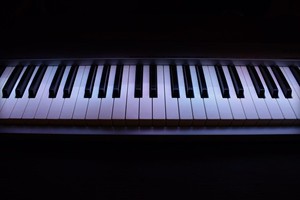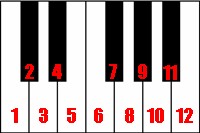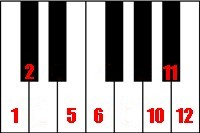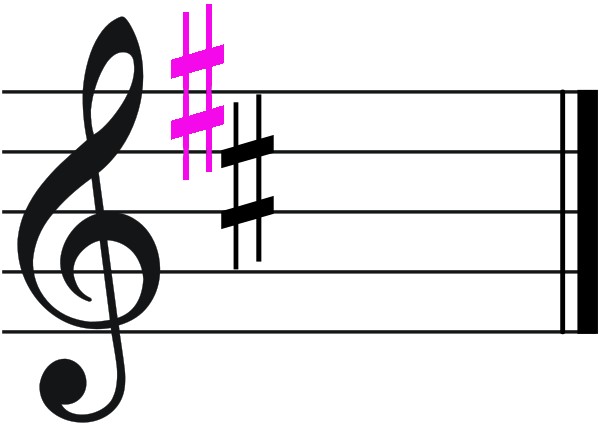Think of any simple song that you may be able to hum or whistle. You may or may not be aware of the key you're humming or  whistling in. You may even be slightly off key (unintentionally). But the song you're performing is in fact in a key of music.
whistling in. You may even be slightly off key (unintentionally). But the song you're performing is in fact in a key of music.
A key of music is a series of compatible notes that form melodies as well as harmonies that synthesize music. These compatible notes correspond to certain scales in music. A scale as well as a key of music is essentially one and the same. I prefer to call a key of music a menu of notes in which you draw from to play a song or piece of music.
In western music, there are actually 12 different notes. But if you randomly draw from the 12 different notes to play a song, it would have no tonal center which would result in a very non musical sound without a beginning or end.
But if you randomly draw from the 12 different notes to play a song, it would have no tonal center which would result in a very non musical sound without a beginning or end. Songs are constructed of western keys of music. You've been hearing them all of your life. If in fact, you were to hear an atonal piece of music (song without a key), you would definitely know it. It wouldn't sound like any popular song you've ever heard.
Songs are constructed of western keys of music. You've been hearing them all of your life. If in fact, you were to hear an atonal piece of music (song without a key), you would definitely know it. It wouldn't sound like any popular song you've ever heard.
To be more specific about a key of music, it consists of 7 different notes that are derived from a pattern of whole steps and half steps.
Whole steps and half steps are just intervals. Intervals are simply the distances between notes.
A half step is the distance from one key to the next by moving from one key to the very next key. A whole step is the distance from one key to the next by skipping a key
A whole step is the distance from one key to the next by skipping a key Among the most common keys of music are Major keys of music. They have the diatonic (in the key) pattern as follows:
Among the most common keys of music are Major keys of music. They have the diatonic (in the key) pattern as follows: Using this diatonic pattern we can find any Major key of music. Such as:
Using this diatonic pattern we can find any Major key of music. Such as:
Now that we know how to arrive at the actual notes of any given key, how does playing in a key of music work?
As I mentioned earlier, I like to think of a key of music as a menu of notes in which you draw from to play a song or piece of music. Let's again take a simple song into consideration.
This animated excerpt of "Jingle Bells" shows us a melody that is in the key of C Major. When a song or piece of music has a preponderance of notes that belong to any particular key, you can be confident it's in that key (most of the time).
When a song or piece of music has a preponderance of notes that belong to any particular key, you can be confident it's in that key (most of the time).
For example, the key C Major consist of these 7 different notes: There's also the possibility that a piece of music with the same notes may be in a minor key.
There's also the possibility that a piece of music with the same notes may be in a minor key.
So how do you distinguish whether a song is in a Major or minor key when you have the same notes?
There's more than one way to determine the key of a song. From the most basic standpoint, the melody itself can indicate the key of a song. If the melody ends on the tonic (first note in the key) then it's a high probability the key is that which is named after the tonic.
In our example "Jingle Bells", the melody ends on C. This melody note brings the song to a resolution. It's very apparent that this is the end of the song.  With a song in the key of A minor, you have exactly the same notes. However, the structure of the key is different. The notes in A minor are in a different order than C Major. The C Major and A minor keys are related. They're known as relative Major and minor keys to each other.
With a song in the key of A minor, you have exactly the same notes. However, the structure of the key is different. The notes in A minor are in a different order than C Major. The C Major and A minor keys are related. They're known as relative Major and minor keys to each other.
Let's take the melody of the song "Wayfaring Stranger" in A minor as an example. The melody of this song ends on A which brings it to a resolution.
Apart from the melody, the harmony of a song is also an indicator of the key. For this reason, it's necessary to understand how basic harmony works.
Each note in a key of music has a corresponding chord. Chords that are native to the key are known as diatonic (as I mentioned earlier). Just as relative Major and minor keys have the same notes, the diatonic chords are also the same but in a different order. These chords will definitely be present when you're playing in any given key of music.
Here's the diatonic chords of C Major as an example:






If we look at our simple song examples, the final chords of these songs are tonic chords (the I chord). This is a common way for songs to end or even end a phrase within a song.
"Jingle Bells" ends on the I chord in C Major
"Wayfaring Stranger" ends on the I chord in A minor
If you're using a form of written music such as a lead sheet, the key signature indicates what key of music the song is in.
Speaking of written music, there are times when notes come across the page that aren't in the key you're playing in. These notes are referred to as accidentals and show up only occasionally. Even when this is the case, it doesn't change the key you're playing in. When the key you're playing in does change, it will often go through a process called modulation. This is essentially pivoting to another key. When this happens, the song may or may not be accompanied by a change in the key signature. Either way, the tonal center will change and your ear will tell you there's something different about the song, even if you don't know what a key change is.
When the key you're playing in does change, it will often go through a process called modulation. This is essentially pivoting to another key. When this happens, the song may or may not be accompanied by a change in the key signature. Either way, the tonal center will change and your ear will tell you there's something different about the song, even if you don't know what a key change is.
What I've shared with you in this article is the essence of what it really means to play in a key of music. I really want to stress that you should take the time to learn Major and minor keys of music. It will unlock and open the door for you to play the music that you've always wanted to play on your keyboard instrument. It will definitely aid you in understanding how music works and what it really means to play in a key of music.
Until next time, Go Play!
Greg Lee
Latest posts by Greg Lee (see all)
- What is a minor/Major 7 Chord? - October 26, 2023
- 7 Chord Substitutions that Professionals Use - October 19, 2023
- 5 Simple Chord Tricks to Sound Amazing - October 5, 2023



